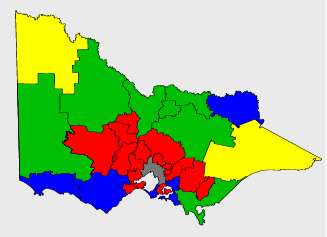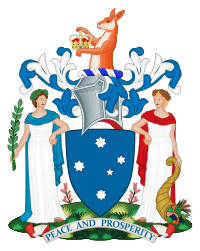2002 Victorian state election
The 2002 Victorian state election, held on Saturday, 30 November 2002, was for the 55th Parliament of Victoria. It was held to elect the 88 members of Victorian Legislative Assembly and 22 members of the 44-member Legislative Council.
| |||||||||||||||||||||||||||||||||||||||||
All 88 seats in the Victorian Legislative Assembly and 22 (of the 44) seats in the Victorian Legislative Council | |||||||||||||||||||||||||||||||||||||||||
|---|---|---|---|---|---|---|---|---|---|---|---|---|---|---|---|---|---|---|---|---|---|---|---|---|---|---|---|---|---|---|---|---|---|---|---|---|---|---|---|---|---|
| |||||||||||||||||||||||||||||||||||||||||
| |||||||||||||||||||||||||||||||||||||||||
The Labor government led by Premier Steve Bracks was returned for a second term with a landslide, taking 62 seats, a gain of 20. It was easily the biggest majority that Labor had ever won in Victoria, and one of Labor's best-ever performances at the state level in Australia. Additionally, it was only the third time that a Labor government had been reelected in Victoria. Labor also recorded 57.8 percent of the two-party preferred vote, their highest on record for a Victorian election.
Jeff Kennett had resigned as Liberal leader soon after his shock defeat in 1999, and was succeeded by former Health Minister Denis Napthine. However, Napthine was unable to get the better of Bracks, and was ousted in August 2002 by Shadow Health Minister Robert Doyle. With just a few months before the writs were dropped, Doyle was unable to recover any significant ground. The Liberals saw their seat more than halved, to 17 seats — their worst result since the 1952 election. Labor also won a majority of seats in the Legislative Council for the first time in its history. The Nationals (who after breaking off their Coalition with the Liberals renamed themselves the 'VicNats') retained the seven seats they held from 1999.
Labor was assisted by a strong economy and by the popularity of Steve Bracks, while the Liberal Party was badly divided between the Kroger and Kennett factions. The Liberal campaign was also damaged by the revelation that the shadow treasurer, Robert Dean, was ineligible to run. Dean's electorate of Berwick had been abolished and merged into the new electorate of Gembrook. Dean won Liberal preselection for Gembrook, but failed to update his address after moving to his new electorate. As a result, he was no longer on the electoral roll; Victorian law requires candidates to be registered voters. Treasurer John Brumby loudly wondered if the Liberals could be trusted to manage Victoria's economy if their shadow treasurer could not manage his own affairs.
This was the last Victorian election where the Legislative Council was elected using preferential voting in single-member districts (while each province has two members, they were elected at alternate elections). The Constitution (Parliamentary Reform) Act 2003 abolished the electoral provinces and divided Victoria into eight regions each electing five members using proportional representation, with all seats being vacated each election.[1]
Results
Legislative Assembly
|
Victorian state election, 30 November 2002[2] | ||||||
|---|---|---|---|---|---|---|
| Enrolled voters | 3,228,466 | |||||
| Votes cast | 3,007,342 | Turnout | 93.16 | –1.05 | ||
| Informal votes | 102,791 | Informal | 3.42 | +0.84 | ||
| Summary of votes by party | ||||||
| Party | Primary votes | % | Swing | Seats | Change | |
| Labor | 1,392,704 | 47.95 | +2.38 | 62 | +20 | |
| Liberal | 985,011 | 33.91 | –8.31 | 17 | –19 | |
| Greens | 282,585 | 9.73 | +8.58 | 0 | ± 0 | |
| National | 125,003 | 4.30 | –0.50 | 7 | ± 0 | |
| CEC | 9,654 | 0.33 | +0.33 | 0 | ± 0 | |
| Democrats | 3,948 | 0.14 | –0.14 | 0 | ± 0 | |
| Socialist Alliance | 3,274 | 0.11 | +0.04 | 0 | ± 0 | |
| Christian Democrats | 1,723 | 0.06 | +0.04 | 0 | ± 0 | |
| Democratic Labor | 1,035 | 0.04 | –0.18 | 0 | ± 0 | |
| Hope | 914 | 0.03 | –0.36 | 0 | ± 0 | |
| Independent | 98,700 | 3.40 | –1.32 | 2 | – 1 | |
| Total | 2,904,551 | 88 | ||||
| Two-party-preferred | ||||||
| Labor | 1,677,856 | 57.78 | +7.58 | |||
| Liberal/National | 1,226,214 | 42.22 | –7.58 | |||
Legislative Council
The following voting statistics exclude the two mid-term by-elections held on the same day, at which one seat each was retained by the Liberal and National parties.
|
Victorian state election, 30 November 2002[3] | ||||||
|---|---|---|---|---|---|---|
| Enrolled voters | 3,228,466 | |||||
| Votes cast | 3,006,200 | Turnout | 93.12 | +0.17 | ||
| Informal votes | 110,422 | Informal | 3.67 | +0.30 | ||
| Summary of votes by party | ||||||
| Party | Primary votes | % | Swing | Seats won |
Seats held | |
| Labor | 1,375,245 | 47.49 | +5.26 | 17 | 25 | |
| Liberal | 999,392 | 34.51 | –5.19 | 3 | 14 | |
| Greens | 314,697 | 10.87 | +8.64 | 0 | 0 | |
| National | 126,419 | 4.37 | –2.91 | 2 | 5 | |
| Democrats | 51,718 | 1.79 | –5.00 | 0 | 0 | |
| Hope | 4,615 | 0.16 | +0.16 | 0 | 0 | |
| Christian Democrats | 4,615 | 0.14 | –0.10 | 0 | 0 | |
| Independent | 19,534 | 0.67 | –0.62 | 0 | 0 | |
| Total | 2,895,778 | 22 | 44 | |||
| Two-party-preferred | ||||||
| Labor | 1,675,893 | 57.85 | +7.74 | |||
| Liberal/National | 1,220,999 | 42.15 | –7.74 | |||
Electoral maps
 | |
| Metropolitan Melbourne: ALP held seats are marked in red. Liberal seats are coloured blue. | Country Victoria: ALP seats are coloured in red, Liberal in blue, Nationals in green and independents in yellow. |
Seats changing hands
| Seat | Pre-2002 | Swing | Post-2002 | ||||||
| Party | Member | Margin | Margin | Member | Party | ||||
| Bass | Independent | Susan Davies | 3.6 | -4.2 | 0.6 | Ken Smith | Liberal | ||
| Bayswater | Liberal | Gordon Ashley | 6.3 | -9.0 | 2.7 | Peter Lockwood | Labor | ||
| Bellarine | Liberal | Garry Spry | 1.1 | -9.3 | 8.2 | Lisa Neville | Labor | ||
| Benalla* | Labor | Denise Allen | 0.4 | -2.4 | 2.0 | Bill Sykes | National | ||
| Bentleigh | Liberal | Inga Peulich | 1.9 | -6.6 | 4.7 | Rob Hudson | Labor | ||
| Cranbourne | Liberal | Gary Rowe | -1.1 | -9.7 | 10.8 | Jude Perera | Labor | ||
| Eltham | Liberal | Wayne Phillips | 3.7 | -8.5 | 4.8 | Steve Herbert | Labor | ||
| Evelyn | Liberal | Christine Fyffe | 12.3 | -12.6 | 0.3 | Heather McTaggart | Labor | ||
| Ferntree Gully | Liberal | Hurtle Lupton | 7.6 | -9.9 | 2.3 | Anne Eckstein | Labor | ||
| Forest Hill | Liberal | John Richardson | 6.2 | -12.0 | 5.8 | Kirstie Marshall | Labor | ||
| Frankston | Liberal | Andrea McCall | 3.2 | -9.0 | 5.8 | Alistair Harkness | Labor | ||
| Gembrook | Liberal | notional - new seat | 6.7 | -8.3 | 1.6 | Tammy Lobato | Labor | ||
| Hastings | Liberal | notional - new seat | 7.1 | -8.0 | 0.9 | Rosy Buchanan | Labor | ||
| Kilsyth | Liberal | Lorraine Elliott | 7.9 | -10.0 | 2.1 | Dympna Beard | Labor | ||
| Monbulk | Liberal | Steve McArthur | 2.4 | -10.7 | 8.3 | James Merlino | Labor | ||
| Mordialloc | Liberal | Geoff Leigh | 2.5 | -7.0 | 4.5 | Janice Munt | Labor | ||
| Mount Waverley | Liberal | Ron Wilson | 9.0 | -11.3 | 2.3 | Maxine Morand | Labor | ||
| Narre Warren North | Liberal | notional - new seat | 5.1 | -14.8 | 9.7 | Luke Donnellan | Labor | ||
| Narre Warren South | Liberal | notional - new seat | 1.3 | -13.9 | 12.6 | Dale Wilson | Labor | ||
| Prahran | Liberal | Leonie Burke | 4.7 | -9.1 | 4.4 | Tony Lupton | Labor | ||
| South Barwon | Liberal | Alister Paterson | 4.7 | -9.7 | 5.0 | Michael Crutchfield | Labor | ||
- Results for Benalla are based from the 2000 by-election, which Labor won from the Nationals.
- Cranbourne became a notionally Labor seat after the redistribution.
- Members in italics did not recontest their seats.
See also
- Members of the Victorian Legislative Assembly, 2002–2006
- Candidates of the Victorian state election, 2002
Notes
- Parliament of Victoria (18 June 2009). "Information Sheet No.7: The Legislative Council's History". Retrieved 3 February 2010.
- Antony Green (July 2003). "2002 Victorian State Election - Summary of Results" (PDF). Retrieved 5 July 2013.
- Victorian Electoral Commission. "Report to Parliament on the 2002 Victorian State election" (PDF). p. 71. Archived from the original (PDF) on September 5, 2008. Retrieved 3 February 2009.



